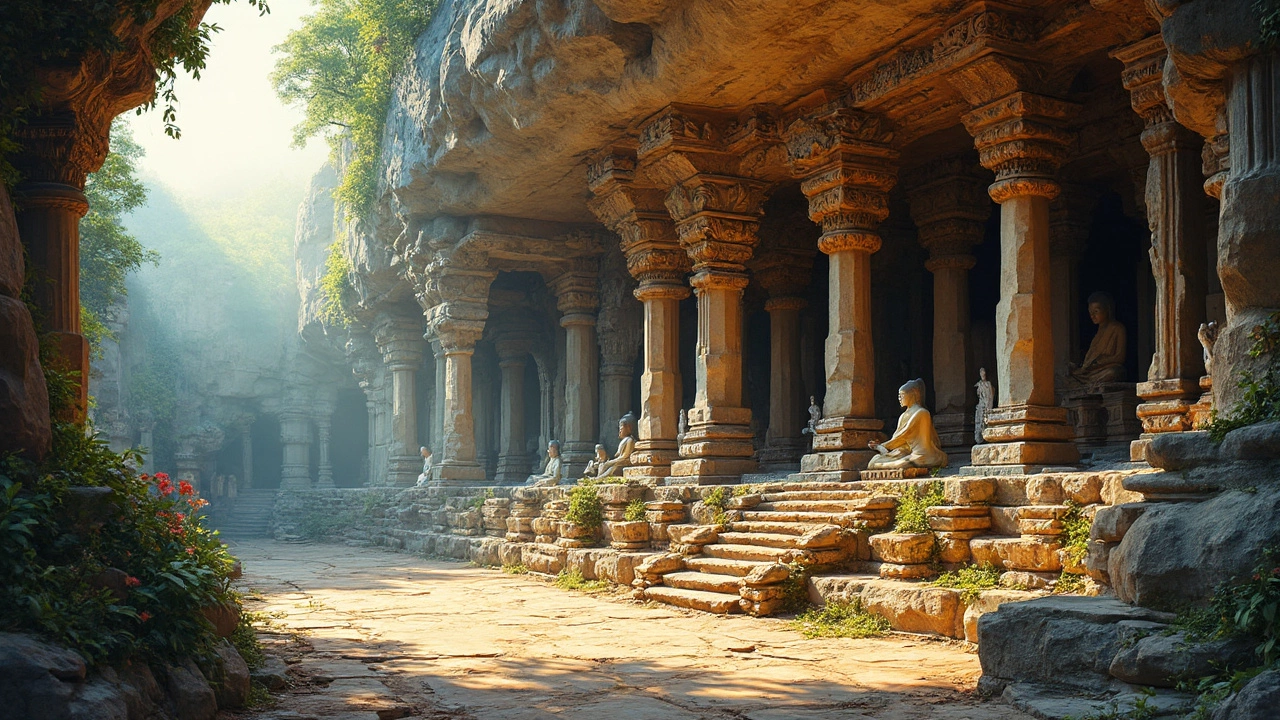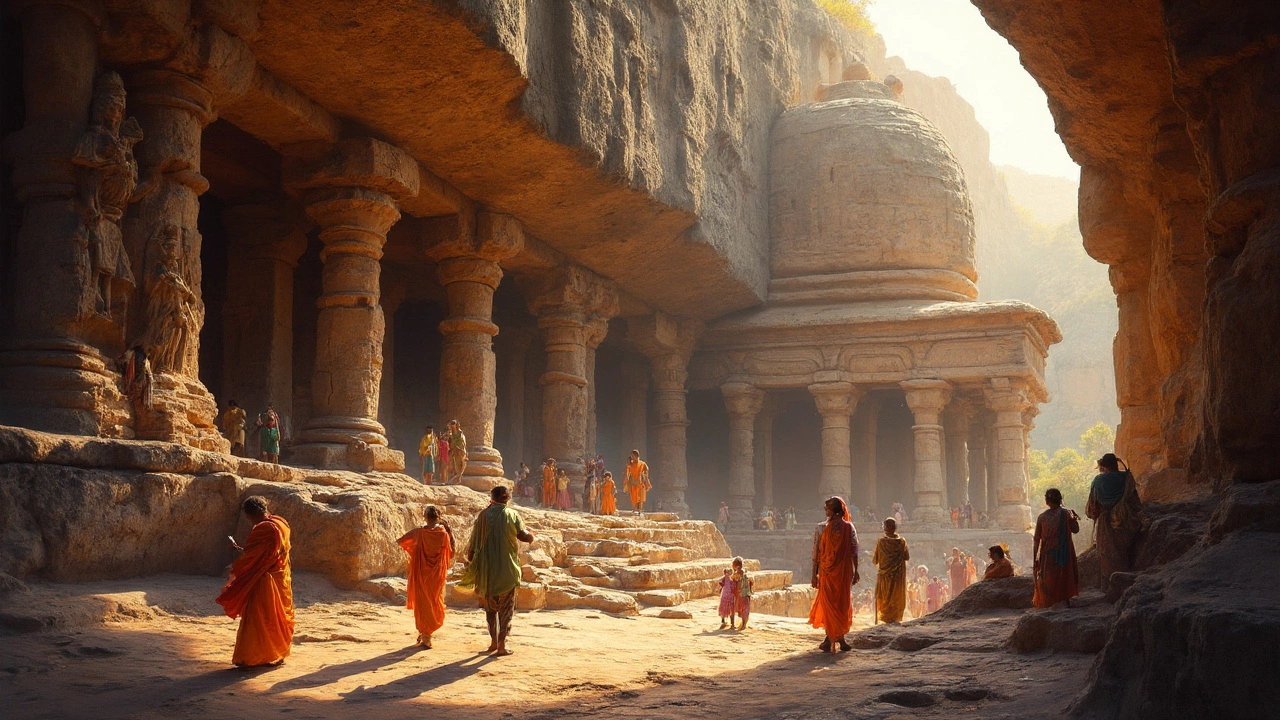Which Indian State Has the Most World Heritage Sites?
 Apr, 12 2025
Apr, 12 2025
Imagine standing in front of ancient cave paintings or majestic forts, each whispering stories of the past. India's rich tapestry of history and culture is vividly displayed in its World Heritage sites, recognized globally for their outstanding value. If you're wondering which Indian state holds the crown for the most of these prestigious sites, it's none other than Maharashtra.
Maharashtra isn't just the bustling home to Mumbai; it also houses an incredible array of UNESCO World Heritage sites. We're talking about iconic places like the Ajanta and Ellora Caves, which are not just rock-cut wonders but a deep dive into India's art history. Imagine chipping away at rock to tell tales of time long gone—crazy, right?
Aside from Ajanta and Ellora, Maharashtra offers the Elephanta Caves and the Chhatrapati Shivaji Maharaj Terminus, each with its unique story and appeal. These sites aren't just bricks and stones; they are pieces of a complex puzzle that define India's rich cultural and historical identity.
Planning to explore these gems? Make sure to visit during the cooler months, carry a good camera, and maybe even hire a local guide. You'll get way more out of your visit with a little context and some insider tips. And don't worry about getting these sites mixed up—each one has its flavor and legend.
- Maharashtra: The Leader in World Heritage Sites
- Exploring Iconic Sites
- Cultural and Historical Significance
- Tips for Visiting Heritage Sites in India
Maharashtra: The Leader in World Heritage Sites
When it comes to Indian heritage sites, Maharashtra takes the top spot, boasting some of the most remarkable and diverse UNESCO World Heritage locations in India. It's not just the number but the variety that makes it fascinating. From ancient caves to historic railway stations, this state has it all.
Let's kick things off with the Ajanta Caves. These rock-cut wonders are around 2,000 years old, showcasing intricate Buddhist paintings and sculptures. They're a visual treat and an archaeological marvel. Not far from here are the Ellora Caves, an Indian culture site that spans multiple religions, featuring Buddhist, Hindu, and Jain monuments. Trust me, the Kailasa temple here, carved from a single rock, is mind-blowing.
On your visit, you can't miss the Elephanta Caves situated on Elephanta Island, not far from Mumbai. These caves date back to the 5th to 8th centuries and are famed for their stunning rock-cut sculptures, especially the enormous Siva Nataraja. It's like stepping back in time.
For something a bit different, head to the Chhatrapati Shivaji Maharaj Terminus in Mumbai. It's not your run-of-the-mill railway station; it's a blend of Victorian Gothic and traditional Indian architecture. You might have seen glimpses of it in Bollywood movies.
If you're planning a visit and are curious about practical tips, here's a quick rundown:
- Best time to visit is from November to February when the weather is cooler.
- Hire a local guide at these sites to make the most of the history and stories behind the structures.
- Photography is usually allowed, but be sure to check the specific rules at each site.
World Heritage sites India are not just about admiring architectural brilliance; they're about connecting with India's vast and varied history. Whether you're a history buff or just love stunning architecture, Maharashtra offers a treasure trove for every traveler.
Exploring Iconic Sites
Maharashtra is like a giant treasure chest when it comes to World Heritage sites in India. First off, let’s talk about the Ajanta Caves. These caves date back to the 2nd century BCE and are a masterpiece of Buddhist religious art. Imagine being surrounded by ancient murals and sculptures that have survived centuries. It's like stepping into a time machine.
Then there are the Ellora Caves, around 30 kilometers from Ajanta. These are unique because they house Buddhist, Hindu, and Jain temples, all cut into the rock faces between the 6th and 10th centuries. The Kailasa Temple at Ellora is particularly amazing. It's carved out of a single block of rock—how’s that for impressive engineering?
If caves aren’t your thing, Maharashtra offers the absolutely stunning Chhatrapati Shivaji Maharaj Terminus in Mumbai. This bustling railway station is the epitome of Victorian Gothic architecture and a testament to India's colonial history. Just take a moment to admire its turrets, stone dome, and pointed arches. It’s a reminder that train stations don't have to be just functional; they can be works of art too!
Another fascinating stop is the Elephanta Caves on Elephanta Island, near Mumbai. Dating back to the 5th to 8th centuries, these caves are dedicated to Hindu god Shiva, featuring impressive rock-cut sculptures. Visiting here is like venturing into another world, where myths and history blend seamlessly.
- If you're planning a visit, Ajanta and Ellora can be combined in a single trip as they're relatively close to each other.
- Consider hiring a guide at these sites. They’ll provide stories and details you wouldn’t get just wandering around.
- Visiting in the cooler months isn't just more comfortable, it helps you avoid the crowds too. Trust me, you'll thank yourself later.
One cool tip: Many of these sites are perfect for photographers. The light inside the caves can create stunning images, so definitely bring your camera!

Cultural and Historical Significance
What makes the World Heritage sites in Maharashtra truly special is their ability to offer a window into the past while standing as testaments to the cultural richness of India. Let's face it, these aren't just tourist spots; they're crucial pieces of history that have molded cultural identities over centuries.
Take the Ajanta Caves, for instance. These caves weren't just carved out overnight; they date back to as early as the 2nd century BCE. What's mind-blowing is the detailed frescoes and sculptures that depict everything from the life of Buddha to ordinary human experiences. Think of them as ancient comic strips—each telling vivid stories without a single spoken word.
The Ellora Caves are another gem. What sets them apart is their representation of three major religions: Hinduism, Buddhism, and Jainism. Imagine living in a time where such diverse traditions coexisted in harmony, each contributing its unique flair to the art and architecture found there.
Elephanta Island's rock-cut caves aren't just tourist stops but a trip back in time, showcasing the glorious Shiva sculptures and relaying tales from Hindu mythology. The stories chiseled into stone here aren't just religious teachings—they offer insights into the sociopolitical context of ancient India.
And then there's the Chhatrapati Shivaji Maharaj Terminus, where Gothic architecture meets Indian sensibility. This railway station isn't just a hub for commuters; it's a symbol of colonial-era grandeur intertwined with traditional Indian motifs, which still stand strong despite modernization.
These sites in Maharashtra do way more than just boost tourism; they preserve stories and customs that continue to influence India's cultural landscape. Every brick, every rock here is a chapter in a story that has been told for hundreds of years. If you're lucky, you might catch a local festival or ritual happening at one of these sites, bringing history and culture vividly to life.
Tips for Visiting Heritage Sites in India
So you're thinking of exploring the rich history and vibrant culture of India through its World Heritage sites? Awesome choice! But a little planning goes a long way in making your trip unforgettable. Let's dive into some helpful tips to navigate your way through these incredible sites.
First up, timing is everything. India has a diverse climate, so it's best to visit from October to March. The weather is cooler and more comfortable, especially if you're planning to explore places like the Ajanta and Ellora Caves in Maharashtra.
Next, consider hiring a local guide. Sure, you can Google tons of information, but guides offer personal stories and insights that make the sites come alive. They're treasures of knowledge, giving you more than just a history lesson—they provide context and cultural depth.
Let's talk gear. Dress comfortably and appropriately. Many sites might have uneven terrain, so sturdy walking shoes are a must. Also, pack a good camera. Trust me, you'll want to capture the stunning architecture and intricate details.
Heritage tourism in India can be overwhelming with so many sites to choose from. Prioritize your must-see spots, and give each place the time it deserves. Rushing through will only make you miss out on the beauty.
Here’s something essential—respect the sites. Remember, many of these are living monuments or sacred spaces. Be mindful of local customs, avoid touching the carvings or paintings, and definitely keep the noise down.
| Top Heritage Sites | State | Best Time to Visit |
|---|---|---|
| Ajanta Caves | Maharashtra | November to March |
| Elephanta Caves | Maharashtra | November to February |
| Chhatrapati Shivaji Maharaj Terminus | Maharashtra | December to February |
And of course, stay safe. Always keep track of your belongings, and follow local advisories. With these tips in your back pocket, you're all set for a memorable dive into India's cultural and historical splendor.